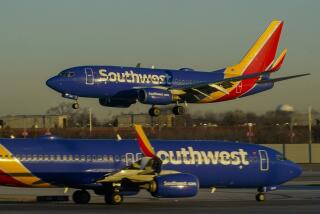The next airline trend could be narrower seats

- Share via
To squeeze more profits from each plane, the airline industry in the last few years has begun to install extra rows of seats, leading to a crunch in legroom that has sparked tiffs and feuds among frustrated passengers.
Now, the squeeze may be on passenger hip room.
United Airlines is considering introducing an economy section on its long-haul Boeing 777-200 with rows of ten seats abreast—instead of the current rows of nine, according to Aviation Week, an industry trade magazine.
The new configuration would allow the airline to add up to 100 extra seats to each plane, depending on the current seat configuration.
In a statement, United declined to confirm the report, saying only, “We evaluate lots of options across our fleet and haven’t made any further announcements specific to the 777 fleet.”
Passengers sitting in United’s current nine-seat economy configuration get a seat width of 18 inches. On European and Middle Eastern airlines that fly the 777-200, which uses ten seats abreast, the seat width is only 17 inches.
American Airlines is now the only other major U.S. carrier with the ten-seat per row configuration, according to SeatGuru.com, a website that compares airline seat features.
If the trend of squeezing seat width continues, it could clash with another unfortunate U.S. trend: More than one-third of American adults are obese, a rate that has been on the rise since the 1970s, according to federal health statistics.
To read more about travel, tourism and the airline industry, follow me on Twitter at @hugomartin.
More to Read
Inside the business of entertainment
The Wide Shot brings you news, analysis and insights on everything from streaming wars to production — and what it all means for the future.
You may occasionally receive promotional content from the Los Angeles Times.











